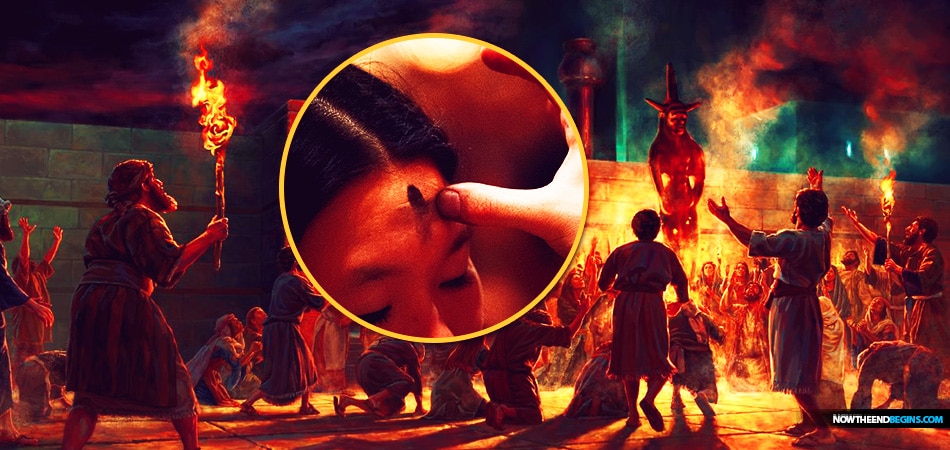
The Roman Catholic Church would have you to believe that Lent is taken from the 40 days that Jesus spent in the wilderness, but is really the pagan rite of Weeping for Tammuz which God hates.
Today begins the first day of Lent, observed primarily by Roman Catholics, but we also see Lenten observances popping up in many Protestant churches, some Baptist churches and in the Church of England. The Roman Catholic Church advertises this is a time of great 'fasting and repentance' before the Lord, but did you know that Lent was taken directly from ancient pagan Babylon? The time you know as Lent began as 'Weeping For Tammuz', one of the many false gods of pagan antiquity.
"He said also unto me, Turn thee yet again, and thou shalt see greater abominations that they do. Then he brought me to the door of the gate of the LORD'S house which was toward the north; and, behold, there sat women weeping for Tammuz. Then said he unto me, Hast thou seen this, O son of man? turn thee yet again, and thou shalt see greater abominations than these." Ezekiel 8:13-15 (KJB)
The Roman Catholic Church would have you to believe that
Lent is taken from the 40 days that Jesus spent in the wilderness, but as you will see, that is not the case. No where in the Bible do we see any command to the believer to observe a 40-day 'period of fasting' prior to the feast of the Passover. Please note the following 40-day periods in the bible.
- It rained 40 days and nights: Genesis 7:4, 12.
- Forty days after sighting the tops of the mountains, Noah set forth a raven and a dove: Gen 8:6-7.
- Joseph mourned the death of his father Jacob for a period of 40 days: Genesis 49:33 - Genesis 50:3.
- Moses on Sinai for 40 days: Exodus 24:18, 34:28, Deuteronomy 9:9-11.
- Moses pleads for Israel 40 days on Sinai: Deuteronomy 9:18-25, 10:10.
- Canaan spied on for 40 days: Numbers 13:25, 14:34.
- Goliath taunted Israel for 40 days: 1 Samuel 17:16.
- Elijah fasted and journeyed to Horeb for 40 days: 1 Kings 19:8.
- Ezekiel bore the iniquity of Judah for 40 days: Ezekiel 4:6.
- Jonah warned Nineveh of judgment in 40 days: Jonah 3:4.
- Jesus fasted in the wilderness for 40 days: Matthew 4:2, Mark 1:13, Luke 4:2.
- Jesus was seen for 40 days after His crucifixion: Acts 1:3.
As you can see, no where does the Bible establish a 40-day period of fasting for the believer in either Testament, so just where does the 40-day period of Lent come from? It comes from the exact same place where Rome got the ideas for a confessional box, for robed priests, for a religious ruling class, it came from pagan Babylon! This is why in Revelation 17 and 18, we clearly see the Roman Catholic Church and its Vatican superstructure presented to us as MYSTERY, BABYLON THE GREAT, and THE MOTHER OF HARLOTS. The apostle John was shown the Church that Jesus shed His blood for, taken over and swallowed up by the counterfeit Roman church which was presented to him as Babylon! No wonder that all he could do in response was to stand there with his jaw hanging down, speechless.
"So he carried me away in the spirit into the wilderness: and I saw a woman sit upon a scarlet coloured beast, full of names of blasphemy, having seven heads and ten horns. And the woman was arrayed in purple and scarlet colour, and decked with gold and precious stones and pearls, having a golden cup in her hand full of abominations and filthiness of her fornication: And upon her forehead was a name written, MYSTERY, BABYLON THE GREAT, THE MOTHER OF HARLOTS AND ABOMINATIONS OF THE EARTH. And I saw the woman drunken with the blood of the saints, and with the blood of the martyrs of Jesus: and when I saw her, I wondered with great admiration." Revelation 17:3-6 (KJB)

CLICK TO READ THE TRUTH ABOUT THE ROMAN CATHOLIC CHURCH WHICH THE BIBLE CALLS MYSTERY, BABYLON THE GREAT
Lent and the Weeping For Tammuz
In his monumental work on exposing the roots of the Roman Catholic Church, called "The Two Babylons" by Alexander Hislop, he tells us this about the Babylonian weeping for Tammuz and its connection to the Roman Catholic Lent.
"Whence, then, came this observance? The forty days abstinence of Lent was directly borrowed from the worshippers of the Babylonian goddess [Astarte / Ishtar]. Such a Lent of forty days, 'in the spring of the year,' is still observed by the Yezidis or Pagan Devil-worshippers of Koordistan, who have inherited it from their early masters, the Babylonians.
"Such a Lent of forty days was held in spring by the Pagan Mexicans, for thus we read in Humboldt, where he gives account of Mexican observances: 'Three days after the vernal equinox .... began a solemn fast of forty days in the honour of the sun.'
"Such a Lent of forty days was observed in Egypt, as may be seen on consulting Wilkinson's Egyptians.
"Among the Pagans this Lent seems to have been an indispensable preliminary to the great annual festival in commemoration of the death and resurrection of Tammuz, which was celebrated by alternate weeping and rejoicing, and which, in many countries, was considerably later than the Christian festival, being observed in Palestine and Assyria in June, therefore called the 'month of Tammuz;' in Egypt, about the middle of May, and in Britain, some time in April. To conciliate the Pagans to nominal Christianity, Rome, pursuing its usual policy, took measures to get the Christian and Pagan festivals amalgamated, and, by a complicated but skillful adjustment of the calendar, it was found no difficult matter, in general, to get Paganism and Christianity -- now far sunk in idolatry -- in this as in so many other things, to shake hands.
"Originally, even in Rome, Lent, with the preceding revelries of the Carnival, was entirely unknown; and even when fasting before the Christian Pasch was held to be necessary, it was by slow steps that, in this respect, it came to conform with the ritual of Paganism. What may have been the period of fasting in the Roman Church before the sitting of the Nicene Council does not very clearly appear, but for a considerable period after that Council, we have distinct evidence that it did not exceed three weeks. The words of Socrates, writing on this very subject, about A.D. 450, are these: 'Those who inhabit the princely city of Rome fast together before Easter three weeks, excepting the Saturday and Lord's day.' But at last, when the worship of Astarte was rising into the ascendant, steps were taken to get the whole Chaldean Lent of six weeks, or forty days, made imperative on all within the Roman empire of the West. The way was prepared for this by a Council held at Aurelia in the time of Hormisdas, Bishop of Rome [514-523], about the year 519, which decreed that Lent should be solemnly kept before Easter. It was with the view, no doubt, of carrying out this decree that the calendar was, a few days after, readjusted by Dionysius."
Source: The Two Babylons, by Alexander Hislop, second American edition, 1959, published in America by Loizeaux Brothers, pages 106, 107.
The Bible Warns Against Weeping For Tammuz
The false god Tammuz is mentioned in the book of Ezekiel. The prophet describes a vision he had, saying the Lord “brought me to the entrance of the north gate of the house of the LORD, and I saw women sitting there, mourning the god Tammuz” (Ezekiel 8:14). God calls the idolatrous practice of weeping for Tammuz a “detestable” thing, made even worse in that it was happening at the temple in Jerusalem.
source
"He said also unto me, Turn thee yet again, and thou shalt see greater abominations that they do. Then he brought me to the door of the gate of the LORD'S house which was toward the north; and, behold, there sat women weeping for Tammuz. Then said he unto me, Hast thou seen this, O son of man? turn thee yet again, and thou shalt see greater abominations than these. And he brought me into the inner court of the LORD'S house, and, behold, at the door of the temple of the LORD, between the porch and the altar, were about five and twenty men, with their backs toward the temple of the LORD, and their faces toward the east; and they worshipped the sun toward the east. Then he said unto me, Hast thou seen this, O son of man? Is it a light thing to the house of Judah that they commit the abominations which they commit here? for they have filled the land with violence, and have returned to provoke me to anger: and, lo, they put the branch to their nose. Therefore will I also deal in fury: mine eye shall not spare, neither will I have pity: and though they cry in mine ears with a loud voice, yet will I not hear them." Ezekiel 8:13-18 (KJB)
So while the Roman Catholic observance of Lent is not in the Bible, the false gods connected with Lent that Jehovah hated are certainly mentioned. God hates Tammuz, hates Ashtoreth, and hates anything connected to the sun worship observed by pagan religions. God hates them because they infected His chosen people, the Jews, who then worshipped these false gods in the groves. Baal, Tammuz, Ashtoreth, Astarte and Ishtar are all connected with pagan sun worship. Note that Lent is a movable observance, connected to and preceding the festival of Easter. Easter is celebrated on a day specified only by the Roman Catholic Church, and not the Bible, and is fixed based on the sun and the Spring or Vernal equinox.
The Origin Of The Pagan Practices Found In The Roman Catholic Church
According to the cult of Ishtar, Tammuz was conceived by a sunbeam, a counterfeit version of Jesus’ virgin birth. Tammuz corresponded to Baal in Phoenicia, Osiris in Egypt, Eros in Greece, and Cupid in Rome. In every case, the worship of those gods and goddesses was associated with sexual immorality. The celebration of Lent has no basis in Scripture, but rather developed from the pagan celebration of Semiramis’s mourning for forty days over the death of Tammuz (cf. Ezek. 8:14) before his alleged resurrection—another of Satan’s mythical counterfeits.
No comments:
Post a Comment